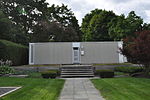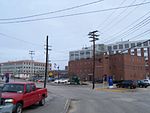Riverside Cemetery (Lewiston, Maine)
Riverside Cemetery is a cemetery in Lewiston, Maine. The 40-acre (16 ha) cemetery is located on the bank of the Androscoggin River which flows through Lewiston. It is owned by the Riverside Cemetery Association.An historic cemetery still in use today, Riverside Cemetery was incorporated in 1855 after a group of city leaders purchased land from Bates College, then known as the Maine State Seminary. Part of the property included the Greenwood Cemetery which had been in use since the 1830s as well as farm land owned by the Whipple Family.Among the original founders of the cemetery were William P. Frye, Alonzo Garcelon, Amos Nevins, Daniel Hamilton, Samuel Bearce, Armis Nash, Samuel Haley, and Donald Holland. Many historically important men and women are buried at Riverside, including 24 Mayors, 2 Governors, 1 Civil War General, 1 US Senator and more than 1200 veterans of wars dating back to the Revolutionary War. Various walking tours are featured highlighting the lives of those who call Riverside their final resting place.The earliest recorded burial was in 1834, Dean Frye, Esquire. The brick residence was built in the 1850s. Designed as a rural cemetery similar to Mount Auburn Cemetery in Cambridge, MA, the serpentine roads of the oldest part of the Riverside's grounds curve among magnificent old oaks and maples overlooking the Androscoggin River. Later development of the cemetery focused on the lawn style of cemetery design which allowed for more symmetrical organization of the lots. Tall obelisks, mausoleums and statuary dot the landscape. Birdwatchers are particularly fond of the many species found there and the City of Lewiston's Androscoggin Riverside Trail which skirts the cemetery's perimeter is popular with walkers and runners.
Excerpt from the Wikipedia article Riverside Cemetery (Lewiston, Maine) (License: CC BY-SA 3.0, Authors).Riverside Cemetery (Lewiston, Maine)
Riverside Place, Lewiston
Geographical coordinates (GPS) Address External links Nearby Places Show on map
Geographical coordinates (GPS)
| Latitude | Longitude |
|---|---|
| N 44.1102018 ° | E -70.2144252 ° |
Address
Riverside Cemetery
Riverside Place
04240 Lewiston
Maine, United States
Open on Google Maps











